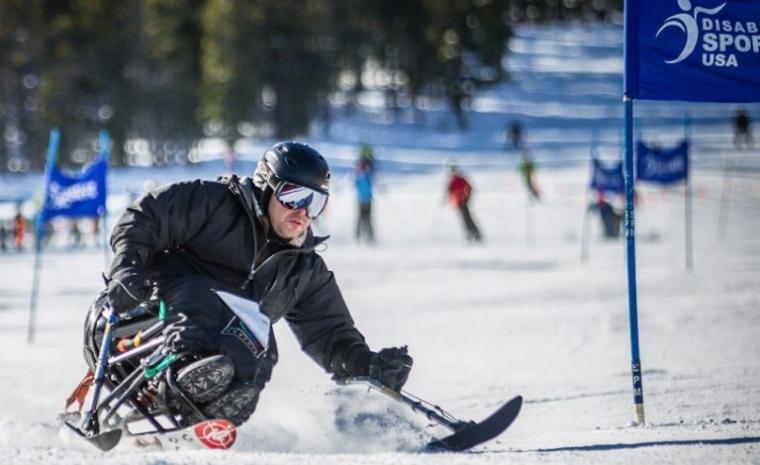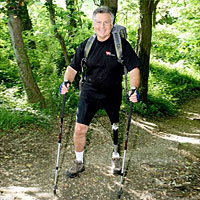
 www.disabledsportsusa.org
www.disabledsportsusa.org
Disabled Sports USA provides national leadership and opportunities for individuals with disabilities to develop independence, confidence and fitness through participation in community sports, recreation and educational programs. The organization has a nationwide network through which over 60,000 youth, wounded warriors and adults are served annually, using over 123 community-based chapters across 41 states nationwide, with programs in over 50 different sports.
Disabilities include those with visual impairments, amputations, spinal cord injury, multiple sclerosis, head injury, cerebral palsy, other neuromuscular/orthopedic conditions, autism and related intellectual disabilities.
Disabled Sports USA also maintains a list on its website, describing various types of adaptive equipment that makes sports possible for individuals with disabilities.

Kirk Bauer: What is even better is that every single sport we are able to teach people is a sport they can share with their family and friends. One of the best examples of this is skiing – there are a lot of ski schools that also offer programs for individuals with disabilities; people will go on a ski vacation and find they’re able to get a lesson and then go out on the slopes alongside their family members who don’t have a disability. We do see that individuals with disabilities can get isolated, which is why social engagement is so important. We encourage people to pick activities they can do with their families or friends.
SDM: Are people taken by surprise about the number of sports available to them?
Bauer: Yes, although there is a lot more awareness now, people are still surprised to learn they can do a specific sport: ‘Really? I can do that?’
SDM: What do you think has contributed to the growth in people becoming more active, despite having a disability?

Bauer: There is much greater accessibility in general, but there has also been an absolute explosion of equipment. There are much lighter metals in prostheses, for example, and those have enabled people to participate in any number of sports. What we’re also involved in is making adaptations to sports, and we have been able to teach people how to get others involved in the sport using that adaptive equipment.
SDM: Is Disabled Sports USA more focused on competition or on providing sports opportunities?
Bauer: We educate our people to also teach about sports for recreation. For us, the stress is more on a healthy lifestyle and not so much on competition. We don’t want people to assume that they shouldn’t try just because they’re not super-athletes. If they’re looking at the Paralympics, we can tell them, ‘That person had to learn the sport first; you can learn it too.’ We also want to let them know they don’t have to be competing at the highest level in order to enjoy that sport.
SDM: Does Disabled Sports USA have competitive events?
 Bauer: We do have some mid-level competitions. Our primary focus, though, is on rehabilitation, recreation and an active lifestyle. As far as we’re concerned, if someone learns a sport and is able to do that any place they want, it’s a success. What people should know, though, is that we are a pipleline organization for the USOC. We can identify athletes with talent and make sure the Paralympics are aware of them.
Bauer: We do have some mid-level competitions. Our primary focus, though, is on rehabilitation, recreation and an active lifestyle. As far as we’re concerned, if someone learns a sport and is able to do that any place they want, it’s a success. What people should know, though, is that we are a pipleline organization for the USOC. We can identify athletes with talent and make sure the Paralympics are aware of them.
SDM: Do you think the Paralympics will help continue to raise awareness?
Bauer: Yes, absolutely. There are a lot of sports out there for disabled individuals and we hope the Paralympics helps them see that. When you have athletes like Tatyana McFadden, it helps to inspire people to become active. I get a kick out of that the same way I get a kick out of the fact that when the Tour de France is on television, you start seeing a lot more people on bicycles.
Something else interesting is that the general public has this limited image of disability in sports; they almost always tend to associate it with a competitive team sport, like wheelchair basketball, or with track and field. One of the things we have found with individuals with physical disabilities is that they tend to gravitate toward individual sports rather than team sports. As a result, they can do their sport more easily in the general recreation environment; they don’t have to get a team together, which can be challenging.
SDM: What do you think are some of the biggest challenges facing athletes who want to participate in competitions along with their able-bodied colleagues?
Bauer: It has always been more challenging for people to travel when they’re disabled, but it is much better than it used to be. I was just involved in a  meeting at the U.S. Department of Transportation, and they were asking groups like ours how air travel could be made easier for people. We all agreed there has been tremendous progress, since they now offer priority boarding, special chairs to get people down the aisle, escorts to meet people at gates and help them get from through the airport if they have to change planes and so on. It really has improved tremendously.
meeting at the U.S. Department of Transportation, and they were asking groups like ours how air travel could be made easier for people. We all agreed there has been tremendous progress, since they now offer priority boarding, special chairs to get people down the aisle, escorts to meet people at gates and help them get from through the airport if they have to change planes and so on. It really has improved tremendously.
The one thing we were focused on in our discussions was the way to transport the equipment people use. For us, that might mean a special piece of sports equipment such as a handcycle or a power chair; there was some good discussion on how to transport those. There’s a need to educate baggage handlers and personnel at airport on accommodating people in that arena.
SDM: What should event owners and rights holders know when they are planning to host an event where there will be athletes with disabilities?
Bauer: Certainly first and foremost, you want to look at the facilities where the actual event will be held, whether that is a track, a ski slope or anything else. There are three important things to look for here: Available adaptive sports equipment, instructors trained to teach with the adaptive equipment and accessible facilities. If it's a temporary situation, accessible port a potties can be rented. Some examples of adaptive sports equipment would include sit-down type snow skies (mono and bi skis) and water skis; a Hoyer lift to get people into a pool or onto a boat, hand cycles, tandem cycles (for blind users who work with what we call a "pilot"), supportive chairs on boats, pulley-type devices for rock climbing, or special swim, running and cycling prostheses, although these are more personal gear. If someone is looking for equipment, a lot of times, one of Disabled Sports USA’s local chapters is able to help. You may also find there are programs available within local parks and recreation departments, and sometimes the facility itself will have access to adaptive equipment. You of course also will want to educate people on how to help out if needed.

Bauer: They are very good at it. Word of mouth is still one of the strongest methods out there. We’ve seen that people really like to use social media; in fact, it’s how our chapters do outreach.
SDM: What’s the challenge for Disabled Sports USA?
Bauer: There is so much information out there that is thrown at people daily, and because of that, our message gets lost. Literally, one of our biggest challenges is to make people aware of the programs we offer and to let them know they can be active. We also have the challenge of getting support, like all private sector non-profits.

